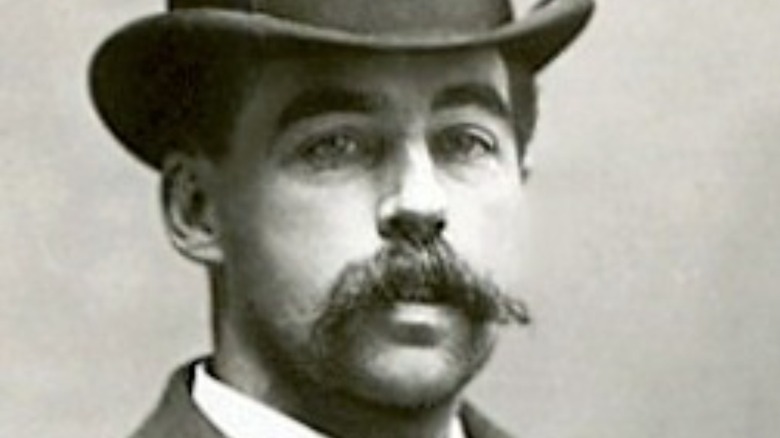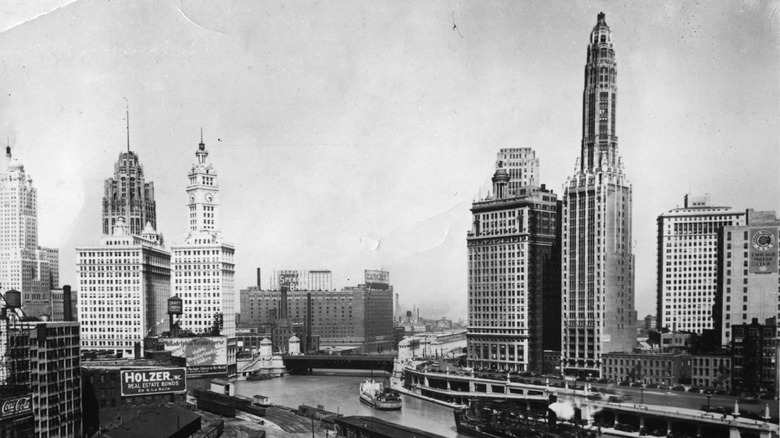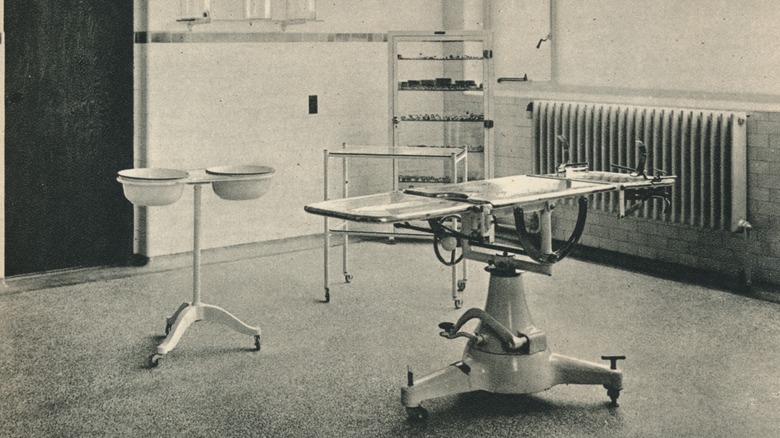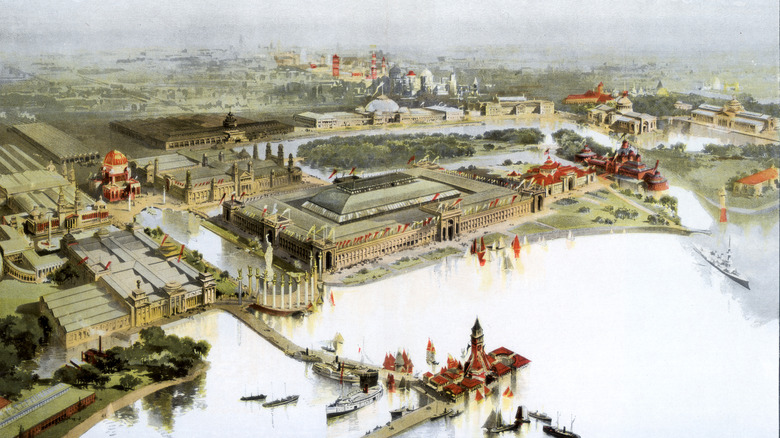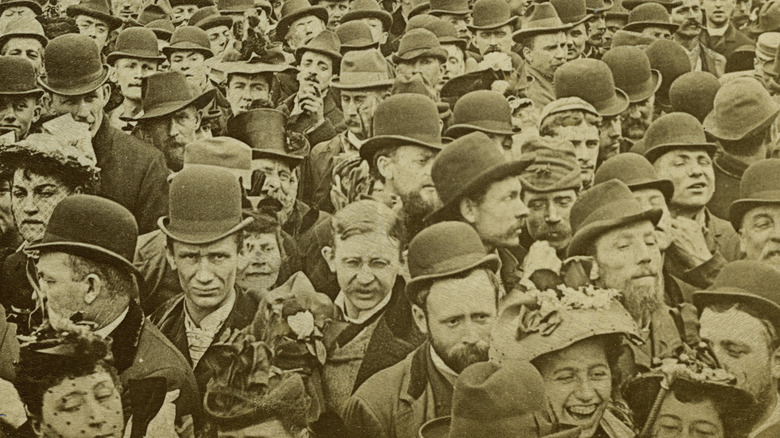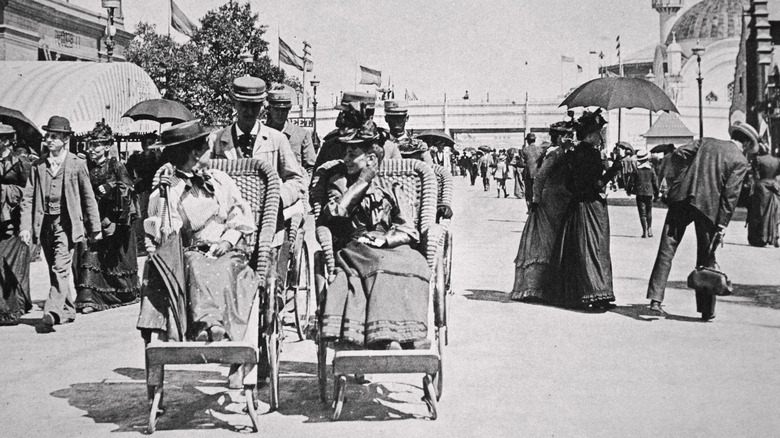Details You Didn't Know About H.H. Holmes' Murder Castle
Way back in 1893, the City of Chicago hosted its first World's Fair (via Chicago Architecture Center), the World's Columbian Exposition. Beating out larger or more distinguished cities like New York and Washington DC, the fair was located in Chicago's Frederick Law Olmsted's Jackson Park. In operation for six months, over 150,000 people visited the expo from May 1 to October 30 (via Library of Congress). Nicknamed the "White City," the fair showcased several large white buildings designed by prominent architect Daniel Burnham. The fair also featured the first Ferris Wheel (via Britannica), a statue of Venus de Milo made of 1,500 pounds of chocolate (via History), and even more importantly, the fair showcased the growing applications of electricity, thrilling Americans who still at that point in history had very little interaction with the newly-harnessed energy phenomenon.
The fair proved a financial success for the city, with the concession stands raising over $4 million in revenue (via Legacy of the Fair) and leaving $1 million in profit that was split up between the 30,000 shareholders of the fair. But beyond all the fun and thrilling successes of the fair, something more sinister was going on in an oddly designed hotel not more than three miles from the World's Columbian Exposition grounds (via Roadside America). What Dr. Henry Howard Holmes, also known as H.H. Holmes, did in his hotel of horrors rivals even the most prolific of the modern day serial killers.
Calling Chicago home
Born Herman Webster Mudgett in Gilmanton, New Hampshire in May of 1861, Holmes was described as being highly intelligent at a young age. According to Biography, Holmes developed an interest in medicine as a youth, where he would "practice" surgeries on animals. Holmes' childhood quest for knowledge eventually led to a friend falling to his death while he explored an abandoned house with Holmes (via Nuvo).
Holmes began committing fraud almost immediately while a medical student studying at the University of Michigan (via Biography). Stealing cadavers from the school, Holmes would study the corpses, then further mutilate them. After taking insurance policies on these already dead individuals, Holmes would set up the bodies to look as if they were killed in an accident, then collect the insurance money (via Crime Museum).
After passing his medical exams, Holmes moved to Chicago in 1885. There he took a job at a pharmacy as Dr. Henry H. Holmes, dispensing drugs to the locals. Not long after taking up employment at the pharmacy, the owner of the drug store died. After convincing the owner's widow to sell him the business, she went missing as well.
While working at the pharmacy in 1887, a nearby lot became available (via True Crime). Holmes bought the lot and began construction on a two-story house. Known as the World's Fair Hotel, the building was designed intentionally with a confusing layout.
The doctor of death
The first floor of the building featured shops, while the guest rooms were located on the second floor. Within the building's 100 rooms, Holmes secretly designed trapdoors that dropped victims in the basement (via History) and secret rooms and staircases that went nowhere (via All That's Interesting). By constantly hiring and firing contractors, Holmes was able to construct a place that would come to be known as the "Murder Castle."
According to True Crime 7, not only did Holmes' Murder Castle have sound-proofed rooms, peepholes with gas lines, and vats of acid, it also housed a laboratory in the basement that contained medical tables, a stretching rack, and even a kiln. It was here that Holmes would dispose of his victims, dissecting them and then dissolving the bodies in acid, selling the skeletal remains to local schools and hospitals.
As construction continued on the building, Holmes took advantage of the upcoming World's Columbian Exposition by adding a third floor to the Murder Castle in 1892. With throngs of tourist and visitors set to hit Chicago, Holmes advertised the third floor as hotel space (also via History) for the Expo. One of Holmes first Murder Castle victims was Julia Smythe. A bookkeeper working at Holmes' pharmacy and living at Murder Castle with her husband Alex Conner and daughter Pearl, Smythe began an affair with Holmes. After catching wind of the affair, Conner split, leaving Smythe and Pearl behind. The affair continued through Christmas of 1891 (via Legends of America) when both Smythe and Pearl suddenly disappeared.
Welcome to the World's Fair Hotel
A few years later, Holmes would strike again. In 1893, actress Minnie Williams ended up in Chicago under Holmes' employ. Working as his personal secretary, Williams owned substantial property in Texas. Holmes convinced her to sign the property over to him (via Advocate Oak Cliff). A few months later, William's siblings Nannie and Baldwin came to visit Minnie in Chicago. In 1897, Holmes admitted to the Philadelphia Inquirer that he murdered Nannie Williams that visit by pushing her into an airtight vault and chloroforming Minnie while she was sleeping. As for their brother, Baldwin, according to Advocate Oak Cliff, Holmes took out a life insurance policy on him, tracked him down in Oklahoma, and killed him.
While it's been estimated that Holmes murdered up to 200 people, it's more than likely the number is much less. According to Legends of America it's been estimated that at least 50 people went missing during the World's Columbian Exposition. With Holmes admitting to killing 27 (via History), it's more than likely his number of murders is somewhere in between, especially since medical schools were paying him good money for the human remains he was selling. In fact, it was his greed that got Holmes' caught. Once the World's fair ended, and potential victims were drying up, Holmes moved to Texas to focus on a new scam, selling stolen horses. According to Crime Museum, after making a fortune selling horses to locals in St Louis, Holmes was caught and arrested for the crime.
Caught
But even being jailed didn't stop the scam artist. While doing time in the clink, Holmes met the "Handsome Bandit" Marion Hedgepath (via Crime Museum). Part of a gang known for robbing trains, Hedgepath was doing a 25 year stint in Missouri State Penitentiary. Holmes devised a plan to take out an insurance policy on himself to the tune of $10,000. As part of the plan, Holmes offered Hedgepath $500 to provide him with the name of his attorney. After being released from jail, Holmes attempted the scam twice, succeeding the second time in collecting the money.
Hedgepath, however, didn't receive any money from Holmes for the tip. While languishing away in jail, Hedgepath decided to turn against Holmes. Informing the authorities of his plan, police found Holmes in Boston living under the name of H. M. Howell (via The West End Museum). On November 17, 1894, Holmes was arrested and a year later was convicted of murder in Philadelphia.
A deadly legacy
Holmes would go on to initially confess to 27 murders, though he would later claim he'd killed more than 130, with the number of claimed murders eventually reaching as high as 200, via Britannica) and swindling people out of hundreds of thousands of dollars. For his confession, Marion Hedgepath's sentence was commuted; only having to serve 14 years of his 25-year sentence.
And while it is true that Holmes created this hotel of horrors, there is some doubt over the number of people he killed. While H.H.Holmes claimed to have killed dozens of people, History casts some doubt on the numbers.
According to author Adam Selzer, who penned the 2003 book "H.H. Holmes: The True History of the White City Devil," Holmes' death toll is significantly less. "There's a total of about nine [people] that we can say with some confidence he probably killed. He confessed to 27 at one point, but several of them were still alive at the time," said Selzer. In fact, the death toll of 200 individuals comes from a book published in 1940 called "Gem of the Prairie." Written by Herbert Asbury, Selzer claims that Asbury greatly exaggerated the number of people Holmes killed, stating: "It had kind of a throwaway line that some people suggested it may have been as many as 200 people. Nobody had actually suggested that, in fact."
There's also a certain level of myth and exaggeration regarding the "castle" itself, the result of fear-mongering yellow journalism of those times.
